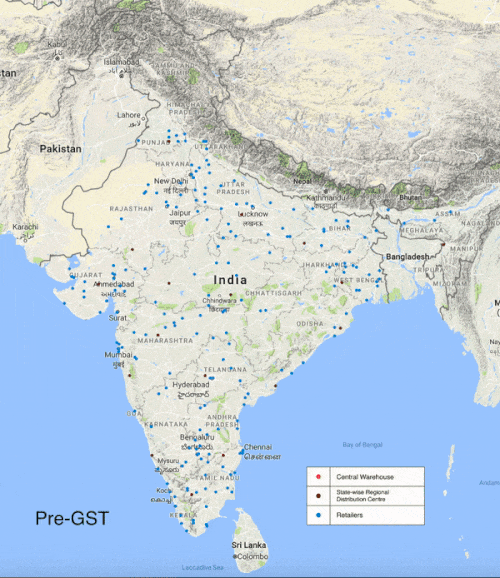Supply Chain Optimization
5 Changes You Need In Your Supply Chain Design Post-GST
Feb 26, 2018
4 mins read
With the introduction of Goods & Service Tax (GST) initiatives, it has become critical for businesses to embrace the inevitable change and redesign their logistics flow to optimise and increase efficiency in supply chain.
Supply chain now involves more than just ‘buying and selling’ of goods. Designing a seamless logistics network determines the fate of the supply chain efficiency and overall customer experience. In this consumer-centric age, optimization of supply chain network considering long-term business goals becomes the only competitive differentiator.
The most significant challenge for managements is to find a sustained alignment between executed operations and formulated business strategies. Most often than not, 90% of the business strategies are not implemented as intended.
Importance of supply chain design post GST
Formally announced last year, introduction of GST created enormous ripples across the seabed of the Indian economy. Poised to challenge the existing status quo, it has become a prime mover in the much needed economic overhaul of our country by integrating India’s multi-layered tax system into a single unified structure, untangling India from its bureaucratic shackles and ease of doing business.

Going back to the supply chain industry, GST is transforming the logistics structure in a country where moving stuff around is notoriously difficult to do. Before, due to the fragmented and uncoordinated transportation sector, businesses were burdened with operational inefficiencies including complex networks, inadequate infrastructure, varied entry taxes and poor vehicle-load-carrying capacities, resulting in delays and damages.

Why should you start optimizing now?
The business requirements of a supply chain network will undergo significant changes which may indirectly affect your operations. Some of them include rising network costs, service lead times, product damage, high inventory investment, ultimately leading to decreased product availability to service demands.
Following are the 5 changes you can implement that help optimize your supply chain design in the post GST era:
- Strategically place your warehouse for increased customer serviceability:
With the elimination of complex interstate tax structures, you can now strategically place your warehouses that help increase customer serviceability with reduced delivery time.
For example, before implementation of GST, standalone warehouses in each state proved advantageous to counter cascading tax structures. Post GST, you can now transport goods directly from your central warehouse located in Delhi to Nasik by eliminating the need to have state-level distribution centers.
This makes supply chains more responsive, by helping adhere to their SLA compliances and pave the way for the possibility of ‘same-day-deliveries’. - Optimize your product flow to reduce cost of logistics operations: Modelling your distribution of goods within your logistics network could prove beneficial in regulating inventory stocks at various hubs, based on historical & future demand data. Along with consolidating your warehouses, freight modelling (including type and number of vehicles) can help reduce your overall fixed & variable costs.
- Optimize your multi-stage inventory management system through Risk Pooling:
Risk pooling refers to the consolidation of inventory across multiple locations into a single & centrallized location.
Based on the variations in demand vs. supply, adoption of a standalone & centrallized warehouse could prove beneficial in decreasing inventory holding costs at various location. This makes the supply chain network lean on inventory and reducing the inventory management costs by 20–30%.

- Intelligently place your inventory to mitigate stock variations: Maintaining a lean supply chain with intelligent inventory modelling allows managers to maintain an optimum level of safety stock to mitigate the risk of run-outs. With the advantage of interstate consolidation, you can order stocks more frequently based on demand variations.
- Simulate risks & sensitivity for better supply chain adaptability: Apart from dynamic business changes, there are many factors that can disrupt your business such as unexpected route restrictions, facility shutdowns and surge in fuel prices. Ensuring responsiveness to the above mentioned factors is critical in designing a robust & flexible supply chain.
The much needed GST debut has brought in transparency and facilitated ease of doing business. In the post GST era, where more power is given to the consumers, redesigning supply chain network can deliver what matters most— world-class customer experience!

This post was authored by: Rashmi Rao
Related Tags:

Route Optimization
How The World’s Best Route Optimization Engine Works
While other traditional ‘track & trace’ solutions tell you ‘where your truck is’, Locus’ route optimization engine goes a step further to answer ‘where your truck should be!’ Consider the following scenario: 10 Shipments, 10 drop-off locations. 1 rider to complete the job in a day. Sounds simple enough problem to solve, isn’t it? Numerous cognitive […]
Read more
Route Optimization
Travelling Salesman Problem Is Not A Problem, It’s A Herculean Task.
There is one problem that never goes out of fashion even though people in mathematics have tried to optimize solutions for it over decades. Yes, decades! To nobody’s surprise, the Travelling Salesman Problem (read: TSP) remains to be one of the most fascinating and complicated algorithms to innovate upon. The solutions to this problem only have a […]
Read moreMOST POPULAR
EDITOR’S PICKS
SUBSCRIBE TO OUR NEWSLETTER
Stay up to date with the latest marketing, sales, and service tips and news


5 Changes You Need In Your Supply Chain Design Post-GST